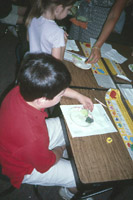Purpose:
This exercise is designed for young children (K to 3) to teach the different parts of a plant (root, stems, leaves, flowers, fruit, and seeds), the basic functions of each part, and to show that tiny microscopic organisms (“germs”) can cause each part of a plant to become diseased. The lesson provides the opportunity to instruct children about different “germs” that infect plants. The laboratory section highlights the lesson by having the children eat different parts of a plant, i.e. a root (carrot), a stem (celery), a leaf (lettuce), a flower (broccoli floret), a fruit (cucumber), and a seed (popcorn) (Figures 1 & 2). The lesson shows children the importance of understanding what causes plants to be sick and the need for scientists called plant pathologists to keep plants healthy. The lesson should last approximately 20 min followed by a 20 min laboratory.
 |
|
 |
|
Figures 1 & 2. First grade children eating different plant parts.
(Courtesy W. Elmer) Click images for a larger view. |
Background information:
Animal life on planet earth would not exist were it not for plants. Plants make oxygen that is needed by almost all animals. Mankind has used plants to provide food, medicines, clothing, flowers, recreation, and building materials. Plants, like people, can catch diseases. Plants become sick and diseased when they are infected with organisms called pathogens. These organisms fall into groups called fungi, bacteria, nematodes, and viruses. Most are so small that they can only be seen with a microscope. When plants that are very important to people become diseased, scientists, called plant pathologists, are trained to help growers protect their crops.
Like people doctors, plant pathologists help growers protect their plants by:
1. Helping growers to determine what disease their plants have and how to avoid the disease.
2. Helping growers recognize the diseased plants early in the season so they can stop the disease before it spreads.
3. Showing growers which types plants they can grow that will be more resistant to disease.
4. Showing growers which plant “medicines” can protect their plants.
